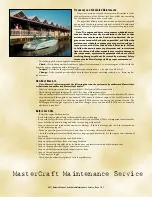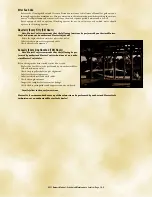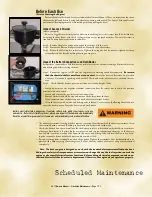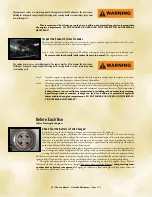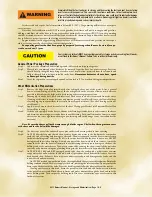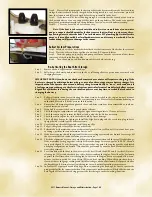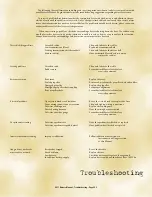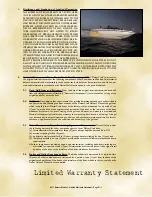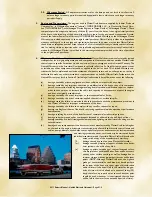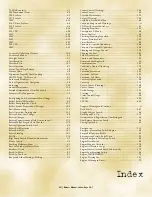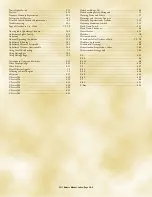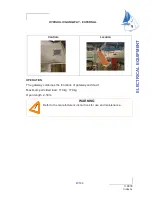
2011 Owners Manual...Storage and Winterization...Page 18-1
Storage and Winterization
Storage or winter lay-up requires special preparation to prevent damage to
the boat. Since winter storage is an annual event, it presents an excellent op-
portunity to perform the annual maintenance at this time, depending upon the
amount of usage. Check with an authorized MasterCraft dealer’s service depart-
ment regarding the boat’s needs to determine if this is the appropriate time for
annual service.
Without proper preparation, storage for long periods of time (at any time of the
year) may cause harm to various components of the boat and drive train. Also,
if the boat has been stored in below-freezing temperatures with water inside the
bilge or engine cooling system (including the heater or, shower, ballast tanks,
wash down tanks, coolers, or any container or area in which water has been lo-
cated), this condition may result in major damage from freezing, which would
not be covered under the warranty.
Refer to the engine owner’s manual for guidance regarding storage and winter-
ization of the engine, transmission and components of the drive train.
The following procedures will help avoid most potential types of damage during storage for a
period not to exceed five (5) months!
Because of the complexity of preparing a boat for proper winter storage, as well as the possibility
of extreme damage to the drive train if a preparation error was made during winterization, Mas-
terCraft recommends scheduling an appointment with an authorized MasterCraft dealer’s service
department to permit a technician to perform all winterization procedures.
General Preparation
Before starting you will need the following supplies:
• Sta-Bil® Gasoline Stabilizer
• Fuel filter
• Low tack tape
Fuel System Treatment
This preparation needs to be done prior to removing water from the engine, if that will be part of the process.
Boats that are going to be stored
for extended periods (more than two [2] weeks) or winterized should have
attention for the fuel system. Even TOP TIER gasolines will experience some separation of elements and settling
during these periods. Of considerable concern is that water condensation will occur within the fuel system, and
water is an enemy of good-starting and running engine fuel systems. Therefore, follow this procedure:
• The fuel tank should be ninety-to-ninety-five percent (90-95%) full of TOP TIER gasoline. This allows for
minimal room in which air can oxygenate the fuel during diurnal cycles (daily periods of expansion/con-
traction of gasoline vapors and air as a result of temperature changes). As temperatures rise in the tank,
the pressure also rises, pushing out gasoline vapor-and-air mixtures. When the temperature falls, pressure
lowers and the system will seek to draw fresh air and water vapor (depending on the humidity level) into
the tank. Fresh air is replaced with “light ends,” which are low-boiling components that vaporize at ambient
temperatures. Light ends are required during cold starts to vaporize the fuel. Since the daily diurnal cycles
eliminate the light ends, a nearly full tank helps to minimize the air volume entering the system.
•
Add a biocide additive in the fuel tank to limit microbial growth in gasoline. Follow the directions pro-
vided by the stabilizer’s manufacturer.
•
Add a fuel stabilizer, such as Sta-Bil
®
, to the fuel tank. Follow the directions provided by the stabilizer’s
manufacturer.
•
Run the engine for at least fifteen (15) minutes while in a body of water. This allows for the circulation of
the additives throughout the fuel system.
•
If possible during storage, the tank vents should be sealed. If the vent is sealed, the tank must NOT be
completely filled. A ninety-to-ninety-five percent (90-95%) filled tank allows room for expansion, which
will be required at certain times when temperatures increase. The hydrocarbons in gasoline react with
naturally occurring oxygen and create a by-product known as “gum.” The substance, as the name infers,
plugs up fuel filters and injectors. Sealing the tank helps reduce gumming by significantly limiting the
amount of oxygen available for interaction with the hydrocarbons.
Содержание prostar 190 2011
Страница 26: ...Guide to Individual Models 2011 Owners Manual Guide to Individual Models Page 4 1...
Страница 81: ......
Страница 93: ......
Страница 105: ......





